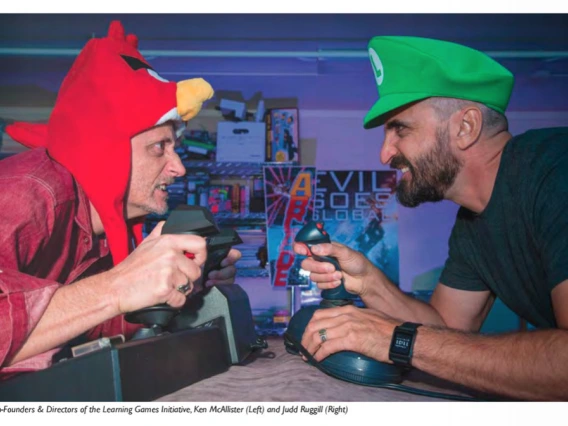
The new Undercover Arts magazine from the Southern Arizona Arts & Cultural Alliance features an article about the Learning Games Initiative:
THE UNIVERSITY OF ARIZONA’S LEARNING GAMES INITIATIVE IS BUILT ON A PASSION FOR CREATIVE TECHNOLOGIES
By Gretchen Harper
Atari. Nintendo. Playstation. Xbox. A personal computer. An arcade pinball machine. We all remember our first video gaming experiences fondly. The colors, the sounds, the music, all igniting a network of pleasure centers in our brains, creating a formula for a powerful sensory memory. You may even have experienced the triumph of snapping a photo of your TV screen on your Polaroid when you finally beat a game. From the rudimentary digital days of Pac Man and Oregon Trail to the mind-blowing graphics and complex story lines of modern games like Grand Theft Auto and Call of Duty – the draw of video gaming has become more striking with the evolution and sophistication of the gaming industry.
If you are a gamer, you’re not alone. Over 1 billion video gaming-enthusiasts play, daily. The study of video gaming, however, is a relatively unexploited field. Tucson may be slightly ahead of the curve. The University of Arizona is home to the Learning Games Initiative Research Archive (LGIRA) -- an impressively colossal collection of video gaming accoutrement. The archive is a visually stunning walk down memory lane, drawing from decades of gaming consoles, peripherals, games, accessories, industrial artwork, promotional materials and many other varied treasures of video gaming culture – a pair of Super Mario Bros Bad Guy knee socks, a Pac-Man belt buckle, a Nintendo Lunch Makers Cheese Pizza Fun Kit, a can of Donkey Kong branded energy drink are among the oddities you’ll find in the collection. The remarkable minds behind this archive of artifacts are the co-founders and co-directors of the Learning Games Initiative (LGI) at the University: Judd Ruggill and Ken McAllister.
The LGI was founded in 1999 as a transdisciplinary, inter-institutional research group that studies gaming, teaches with gaming technology, and builds computer games. The archive now contains more than 250,000 items and has the distinction of being one of the largest gaming archives in the Americas. The archive has a unique philosophy of preservation through use: meaning every element in the collection may be touched and, in most cases, played. Ken and Judd believe that more is learned by using the items than by simply viewing them and that our memories are more durable than the items themselves. “The operative principle of LGIRA, in other words, is that deep human memory of the archive’s artifacts can be both more timeless and more accurate than less experiential forms of study.”
But that’s just the beginning. Judd and Ken are scholars of the gaming industry at large and have ample publications on the subject under their belts. They have extensively studied the relationship between gaming and the arts and define how art and design are indelible and essential elements of the gaming industry.
“The visual composition is as fundamental as the gaming experience itself,” Judd explains. “Twenty plus artists may be hired to create the art assets of a game. Creating the visual elements are highly collaborative and may take 18 months to complete. The power of a game’s potential to resonate with players lies in the aesthetic.”
Video game artists work under a Lead Artist who will supervise the development of character design, environments, surface textures, accessories, 3D modeling and storyboarding. The complexities of building a given gaming universe require an advanced and unique skill set.
“Becoming a video game artist is highly competitive,” Ken points out. “A combination of sharp artistic ability, a well- developed sense of spatial composition, and of a deep knowledge of animation and 3D modelling are requisite credentials. Game artists must be comfortable with having their artwork altered, potentially multiple times, to meet the stylized needs of the game and technical limitations of the platform.”
Video gaming has continued to progress at break-neck speed. Virtual Reality (VR) and Augmented Reality (AR) are quickly becoming central in the digital landscape. VR and AR emerging technologies are valuable, not just in video games and recreation but in more specialized disciplines, as well.
“Gaming companies are not the only employers of digital designers. Talented VR artists are in high demand by the Department of Defense,” Ken says. “The skills of talented gaming designers are highly sought after for military training and modeling purposes.”
Video game development is certain to become more accessible to aspiring game creators as costs of the required technology decline, according to Ken and Judd. The current hot beds of gaming production like Silicon Valley, Tokyo and Seattle will be given a run for their money as other creative cities come online. Judd predicts that Tucson has a high potential to be amongst those cities.
Games as a learning tool have been a staple in education and vocational training across time, and video gaming, in particular, is becoming more conventionally accepted as a highly effective tool for learning – particularly with more technical subjects like mathematics. Video gaming studies have been shown to improve brain function as well as to reverse cognitive brain loss. Strong correlations are also being shown between video gaming and motivation to learn. Gaming designers are at the heart of creating beautiful worlds in which learners can dwell.
The broad popularity of video games and gaming culture is inextricably linked with the arts and the visionaries that create them. The ability to become immersed in a story as one might with a movie, is amplified in its pleasure by the ability to control the characters, to become part of the story. The enriching experiences afforded by video games are, without doubt, remarkably valuable and an unforgettable part of our human experience.

